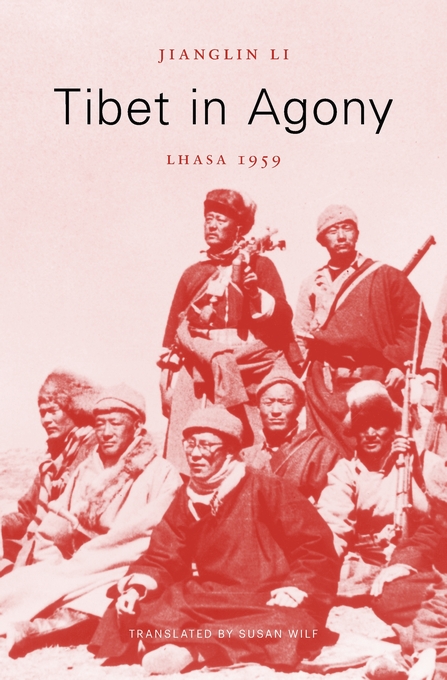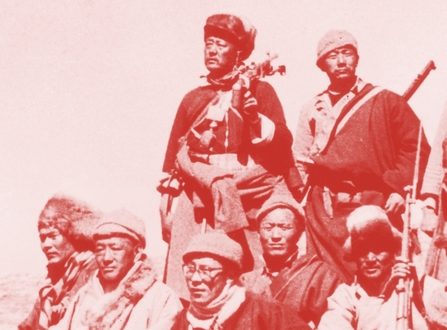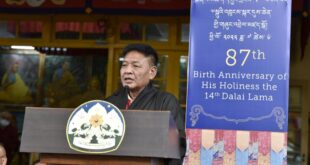
Tibet in Agony: Lhasa 1959, written by Jianglin Li and translated by Susan Wilf, is the first detailed assessment of the events leading up to the Dalai Lama’s flight from Tibet into exile in 1959 that draws extensively on Chinese civil and military sources that have become available in recent years. Standing as the most comprehensive account to date of the most important historical event in contemporary Tibetan history, the book is a critical counter to the official Chinese narrative on Tibet. The shaping of that narrative is of course ongoing, and in recent months the government’s efforts to destroy the world’s largest Buddhist institute have offered further evidence of Chinese governmental fear of any movement, religious or social, that it can’t fully control. Below, in Wilf’s translation, Jianglin Li puts the assault on Larung Gar in the context of China’s history of cracking down on Tibetans.
Recent bulldozing at the enormous Larung Gar Buddhist Academy complex in Sichuan is emblematic of the Chinese Communists’ refusal to tolerate Buddhism—or any religion—as a rival source of authority. The forcible eviction of thousands of the academy’s resident monks and nuns is an incalculable loss for the entire Tibetan community. In addition to tending to people’s spiritual needs, the modern Tibetan Buddhist clergy also spearheads a public drive for responsible, ethical behavior. Thus, the Communists’ blind intolerance goes beyond religious persecution: it places them paradoxically on the wrong side of many other pressing issues, from animal cruelty to AIDS prevention.
For example, when the Dalai Lama called upon Tibetans in 2006 to help save endangered species by giving up their tradition of wearing exotic furs, they responded by tossing their animal pelts into bonfires. The Chinese Communist reaction to this demonstration of faith in the Dalai Lama has been to force Tibetans to wear furs to prove their loyalty to the Communist Party instead, and many Tibetan objectors have been beaten or jailed.
In recent years, the monks and nuns of Larung Gar and other Tibetan Buddhist centers have promulgated a set of modern vows for lay Tibetans—persuading people to renounce common vices such as gambling, fighting with weapons over pastureland, alcohol abuse, smoking, unsafe sex, and needless animal slaughter. With the expulsion of the clergy, however, these initiatives may be doomed.
The Chinese Communist repression of Tibetan Buddhism dates to the 1950s, when most monasteries were systematically dismantled in the name of “religious reform.” All religious leaders who were unwilling to be co-opted by the Communists either fled into exile or went to jail. As the Tibetan ethical system deteriorated along with the loss of leadership, the Communists attempted to instill “socialist values” in a series of campaigns, reaching a climax in the Cultural Revolution, which destroyed the few remaining monasteries and left an ethical vacuum in its wake.
When religion was allowed a limited revival in the 1980s, Larung Gar Buddhist Academy was founded. Through its welcome of a highly diverse student body, it soon became the largest Buddhist academy not only in the Tibetan regions, but in the world, with somewhere between ten and twenty thousand students. Han Chinese students came too, and took their message back home, spreading the influence of Tibetan Buddhism in Chinese society. Increasing numbers of people turned to the religion, partly filling the ethical void.
The religious comeback put the Chinese Communists into a double bind: they could not close the monasteries again, nor could they allow religion to mushroom beyond Communist control. In 1993, then Party Secretary Jiang Zemin formulated a “religious policy for the new era,” requiring religious believers to love the Motherland and the Party above all else, and to “adapt religion to socialism.” But who would decide which religious tenets should be “adapted?” The Communist Party, of course. It has conducted large-scale evictions at Larung Gar before, in 2001. And when Kirti Rinpoche, head abbot (in exile) of Kirti Monastery in Sichuan, issued a popular set of thirty-two basic ethical precepts for contemporary Tibetans, the Communists banned it.
The signals from the Chinese Communists to the Buddhist community are clear. Despite their lip service to social stability and harmony, what the Chinese Communists want most of all is to show everyone who’s boss.


